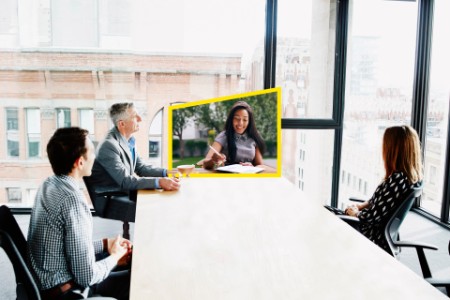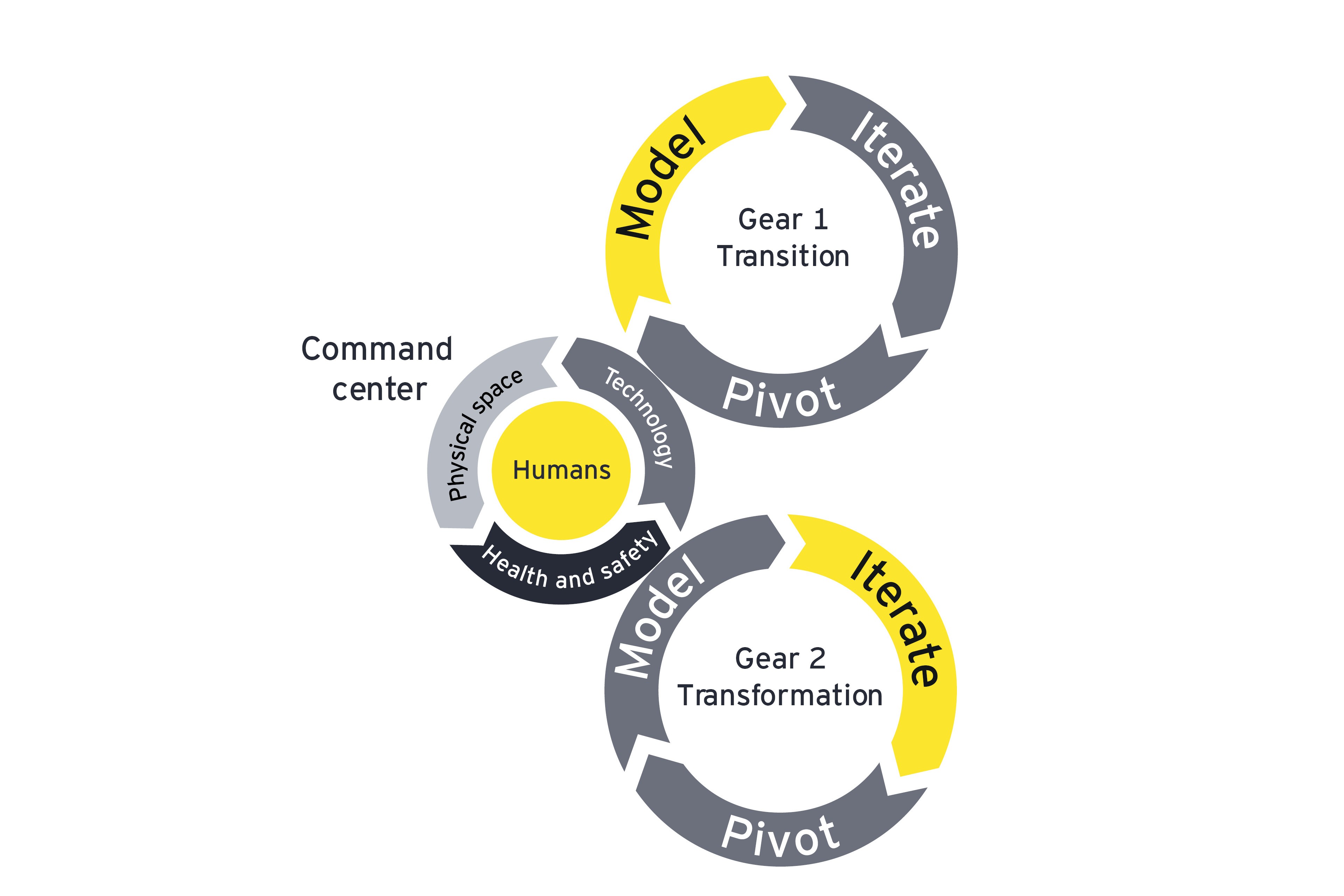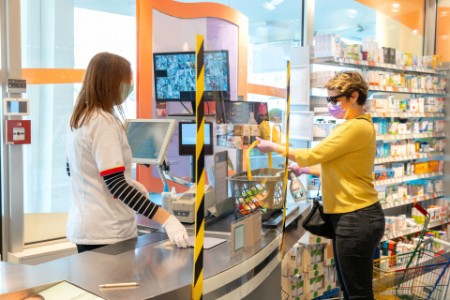
Chapter 1
Managing the physical return to work (Gear 1)
Driving the conditions for a trusted transition
Putting humans at the center means confirming it’s safe to return to the physical workplace. Employees and customers need to feel confident their safety is protected; companies need to build trust by clearly demonstrating protective measures and strongly communicating them. Ikea, for example, is counting people to limit the number of shoppers in stores. It has put up protective screens for staff offering assistance, and closed its childcare and restaurant areas. Other retailers are doing likewise, with strict health screening and physical distancing controls to safeguard staff.
Overseeing changes such as this and managing through uncertainty requires the establishment of a cross-functional command center that facilitates agile decision-making, scans the horizon for both threats and opportunities to improve operations, and responds to changing market and health conditions. Sitting between the two gears, the command center leads the trusted transition back to the workplace.
Command center: bringing order to uncertainty
A command center provides a fulcrum to manage the transition back to physical work and responds to changes in the internal and external operating environment. The command center team engages internal and external stakeholders to support a coordinated response, including the executive team and board, workforce, customers, value-chain partners (suppliers, vendors), government/local agencies and community, and validates that compliance and fiduciary obligations are met. It must think holistically about operational continuity, considering technology, security, productivity, wellness and engagement. And, using what is learned, it must adopt a forward-looking view as to what work looks like for the business.
Creating playbooks for a trusted transition
Physical return work stream playbooks can clearly set out how the command center communicates actions across the organization. These playbooks — ranging from worker health and safety to workplace and site safety, financial stability, government and legal compliance, and others — can document principles and set out tactical steps and information to facilitate the recovery and resumption of business operations. They will need to be continually updated, and will complement existing business continuity plans by focusing on the specific functional area responsibilities that link back to the command center. In addition, data and analytics will play a significant role by enabling new operational insights across these work streams for timely decision-making.
Below we’ve outlined considerations and actions that these workstream playbooks should cover.
Above all of this, in times of uncertainty, leading from the front is critical. Leadership needs to be visible: build confidence, model new behaviors and help managers support their teams.
Health and safety
Companies implementing the physical return of large swaths of their workforce are already planning waves of return, each in limited numbers, to preserve social distancing. Leaders must decide who needs to go back to the workplace as a priority and are innovating with staggered shifts, alternating so-called blue and red teams, and experimenting with longer-term remote working arrangements for some.
Samsung has implemented wide-ranging efforts to curb the spread of the virus while minimizing business disruption.2 The company mandated its employees should work from home unless it’s essential to be present at a workplace, and it has tightened coronavirus screening procedures for chip plants, including daily health screenings and requirements to answer weekly, online self-examination questions regarding the outbreak. Samsung also has restricted international travel to only “mission-critical journeys” and created task forces around the globe to track and implement the latest expert insights.
Business leaders also must navigate different regional regulations governing safe return to the physical workplace and implement leading practices. These measures include staggered start and finish times to minimize commuter congestion as well as “bunching” at entry points; temperature testing; frequent handwashing regimens and sanitizer availability; deep-cleaning protocols, especially for high-touch surfaces; personal protective equipment where mandated by governments, or for people who are exposed to proximity risks; and on-demand health care and access to telehealth support.
Technology
Many employees have been catapulted into the use of videoconferencing and cloud-enabled file-sharing to replace physical meetings and traditional ways of working. These have often proved efficient and productive, enabling these technologies to become embedded in workplace processes so that some employees are now empowered to work remotely for the longer term.
Various contact-tracing technologies — such as Bluetooth-enabled wristbands and smartphone apps, like MIT’s COVID Safe Paths — are already being used by some governments and companies to help safeguard health in the event of a confirmed infection. Trust that the use of such data is for personal protection only — and not for wider surveillance — is central to widescale adoption and compliance. Organizations will need to safeguard data to comply with local regulations.
“Employers can’t leave it to governments or big tech alone to solve the challenges arising from the pandemic,” says Jeff Saviano, EY Global Tax Innovation Leader. “These problems can only be solved through smart collaborations amongst various stakeholders across the public and private sectors, and civil society.”
Companies that have reopened are considering how to replace high-touch items such as trash cans, or use technology to mitigate risk to keep employees safe and work environments clean. And more advanced technologies are being piloted, from thermal imaging cameras to voice-activated controls for elevators and doors. At Ford’s plant in Plymouth, Michigan, for example, workers are testing a smartwatch that uses Bluetooth shortwave technology to detect proximity between workers and vibrates to alert supervisors.3
In addition, companies are adopting AI and data analysis to build scenarios, test hypotheses and envision the what-if circumstances that will form the basis of emergency plans that can be implemented immediately should a localized outbreak occur. In short: model, iterate and pivot.
Physical space
Every business reopening after lockdown has to reconfigure workspaces to maintain social distancing. Measures include orienting employees back-to-back or side-by-side, rather than face-to-face; spacing employees farther apart on assembly lines; designated seating in offices rather than “hot desking”; limited elevator use; installing signage to help maintain distance at communal facilities such as photocopiers, coffee points and bathrooms; and temporarily closing socializing hubs such as canteens and informal breakout areas.
Mitigating risk on high-traffic and high-touch surfaces can also be achieved without technology. An Australian technology company has replaced door handles with foot handles made from wall brackets to avoid doors being touched by its employees, for example.4 These modifications are only short-term adjustments for the sweeping changes to physical space that will come as a result of the COVID-19 pandemic.
Companies will re-evaluate their real estate footprints and physical space needs, including who needs to be in an office location and for what percentage of the working week. And those employees who remain working in company offices will have more space. While the average real estate space per employee has been in decline since the 2008 financial crash,5 the COVID-19 pandemic is likely to reverse this trend. For those employees who return to the office, social distancing guidelines signal the end of open office floor plans.
Mark Grinis, EY Global Real Estate, Hospitality and Construction Leader, summarizes what to expect: “The future of real estate is forever altered after the COVID-19 crisis. Our experiences from adopting more virtual lifestyles has changed the perception of what’s possible which, in turn, will challenge the role of the physical environment. There is both an urgent need for immediate adjustment of physical space to protect health and safety in the return to work, while planning for longer-term adjustments to how people prefer to work, shop, learn and be entertained.”
Gear 1 provides immediate, actionable steps to put people at the center of the physical return to work. Here are some questions to help push your preparations forward.
Humans at the center — Gear 1: considerations for a trusted transition
Employee |
Customer |
Supplier/partner |
Citizen |
|
Health and well-being |
How are you prioritizing employee health and well-being in both physical return to work and remote work? |
What is your playbook for enhancing cleanliness and protecting the health and safety of your customers? |
How do you maintain a culture of care and collaboration with your supplier network and partners? |
How do your policies impact and prioritize health, safety and the general welfare of the public? |
Physical space |
How will you make your employees feel safe in physical return to the office and productive in continued work from home? |
How are you changing your physical environment to adjust to new preferences and keep customers healthy and safe? |
How do you coordinate health and business continuity with suppliers and partners with the return to physical work? |
How can the steps you make to reimagine your physical environment show you are being proactive and accountable to local and global communities? |
Technology |
Are you equipping your workers with tools and technology to feel safe and be productive and connected? |
How are you using touchless digital technology to adjust delivery models to meet customer needs? |
What integrated analytics will maintain connection and continuity with suppliers and partners? |
How can you communicate with, crowdsource inputs from the public to help shape the approach and share a transparent response? |
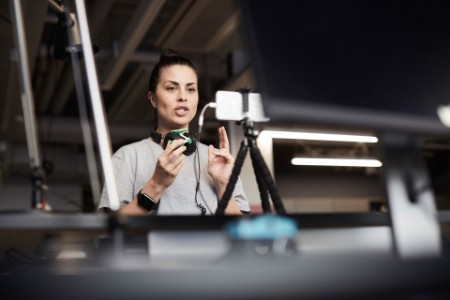
Chapter 2
Re-inventing work, fast-forward (Gear 2)
Driving adaptation and transformation for a different working world
We all need to become futurists — not just to model potential or plausible futures, but also to invent and design them. The way work is managed is still largely modeled on the production lines of the early 20th century. There is a strong imperative now to synchronize technology and the shape of work to 21st century needs.
In many companies, work is still organized in defined roles within a command-and-control structure and a hierarchical culture. Many leaders promote an attendance ethos that rewards physical hours in a location rather than productivity. This isn’t the best way to organize your business: the workplace of the future should be much more digital, much more flexible and much less hierarchical.
Leaders will need to continue to optimize how work is done for efficiency and productivity. But you must focus more on the experience of employees. The culture of online work is in the process of being rewritten, as organizations apply the lessons of the COVID-19 pandemic to the longer term. The ability to attract the best talent will depend significantly on the flexible experiences your company can offer. Critical to that will be the culture your organization demonstrates and the collaborative action toward a defined purpose that energizes it.
Health and safety
We’re people first; employees second. Companies that win in this new economy will be those who care about the total well-being of staff (physical, mental and financial health) and put humans at the center.
The immediate focus on hygiene has accelerated the use of touchless systems and voice-activated controls; the new emphasis on washing and cleaning — both hands and surfaces — is now so much a part of our daily routines that we expect these measures to last. In China, for example, there is increased use of voice-activated elevators,6 post-COVID-19. And companies, such as Microsoft have been developing new “noise-robust” automatic speech recognition technologies that can filter out background noise.
Mike Bertolino, EY Global People Consulting Services Leader, says: “Through the prism of ‘people mattering most,’ companies should be asking first and foremost: How do I keep my employees safe? How do I keep my customers engaged? How can my company help society? Companies who live their purpose through COVID-19 will generate long-term value that will pay dividends long after the crisis has passed.”
This culture of care will inform everything a company does as it applies the lessons learned from the pandemic to a new business cycle defined by value more than growth.
Technology
“Leading companies will emerge from the current crisis with the motivation to reboot and rebalance,” says Dan Higgins, EY Global Consulting Technology Consulting Leader. “Leaders need to examine their efforts for a trusted transition to transform their companies through a new lens and a different set of value drivers: putting humans at the center of their purpose; innovating at scale through ecosystems of partnerships and alliances; and deploying technology at speed.”
Automating routine processes removes drudgery from the human experience of work, elevating that experience to more creative and rewarding tasks.
As companies compete for key talent, more flexible ways of working that harness digital communication apps can improve work/life balance and meet employees’ personal preferences. Validating that the workforce is on a constant trajectory of training will enable a culture where no one is left behind as new technologies are embedded in business processes. For example, LinkedIn launched numerous courses focused on leading and working with remote workforces, including how to maintain an executive presence virtually.
As the use of advanced technologies in more and more business operations proliferates, cloud strategy and scalability are essential, as are cybersecurity controls. And the use of digital twins will become critical to strategic planning by helping model every business operation to uncover ways of improving it, from supply chain management to production processes and logistics to customer access.
Bayer Crop Science, for example, uses digital twins that model each of nine corn seed manufacturing sites across North America.7 Through the use of AI, these virtual factories create long-range business plans and perform what-if analyses to improve processes and identify new approaches.
Physical space
Not all future work will have a set physical location. In some sectors, almost everything can be done remotely, greatly reducing real estate needs. Some companies are proving they can operate without a real estate footprint, with the office essentially serving as a flagship conference center — not a workplace. Insurer Nationwide, for example, has 98% of its workforce operating remotely during the COVID-19 pandemic.8 It has already announced a permanent shift to a hybrid workforce model, with working from the office limited to four main corporate campuses and working from home in most other locations.
As companies look at a flexible workforce, there may be an increase in work done by contractors, or gig workers, that sit outside the organization. But the pandemic has also shown contractors to be particularly vulnerable, and there may be moves to offer them employment safeguards and benefits similar to internal employees.
Where work does need a fixed physical location, companies will focus on making this location more flexible (for example, through modular office space) and adaptable to new production processes, new technologies and new ways of making. The interrelatedness of physical location and technology will only increase.
Gear 2 is about preparing for the “next normal” so workforces are better able to drive long-term value for themselves, customers, suppliers and citizens. Here are some questions to help you reimagine the future of work within your organization.
Humans at the center — Gear 2: considerations for work/service reimagined
Employee |
Customer |
Supplier/Partner |
Citizen |
|
Health and well-being |
How will you address chronic and acute well-being issues (physical, financial, social and emotional) in a transformation road map? |
How will you embrace and promote aligned customer cultural and behavioral shifts? |
How do you build resilience and assess the consistent well-being of supplier networks? |
How will you integrate health and well-being into the purpose and long-term value of your business? |
Physical space |
Do your physical work environment and work-from-home policies reflect employee preference, choice and a new workforce model? |
How will you reimagine customer contact in your physical space to maximize customer value? |
Is there agility, flexibility and measurement in your physical space and operating model to accommodate shocks? |
What steps will you take to reshape your physical workspace to meet leading standards of environmental and building health practices? |
Technology |
How will you use technology to augment people, collaboration, learning and new ways of work? |
How will you re-invent business and delivery models to enhance the customer experience? |
How will you reimagine and optimize your technology stack to broaden collaboration and accelerate your innovation ecosystem? |
How will technology with humans at center reshape the value that you deliver to the public by creating local jobs and skills? |
Engaging with what you are thinking and doing
The COVID-19 pandemic has turned our world upside down. It’s also magnified the need for collaboration. With this report, we’re launching a survey and “jam portal” on our MillionYou platform to hear from all parts of the global community. We want to know how you are managing the crisis, how it has affected you and your workforce, and how you think it will reshape and reimagine work. We’ll share real-time data to show perspectives and leading practices from a range of countries, sectors and people.
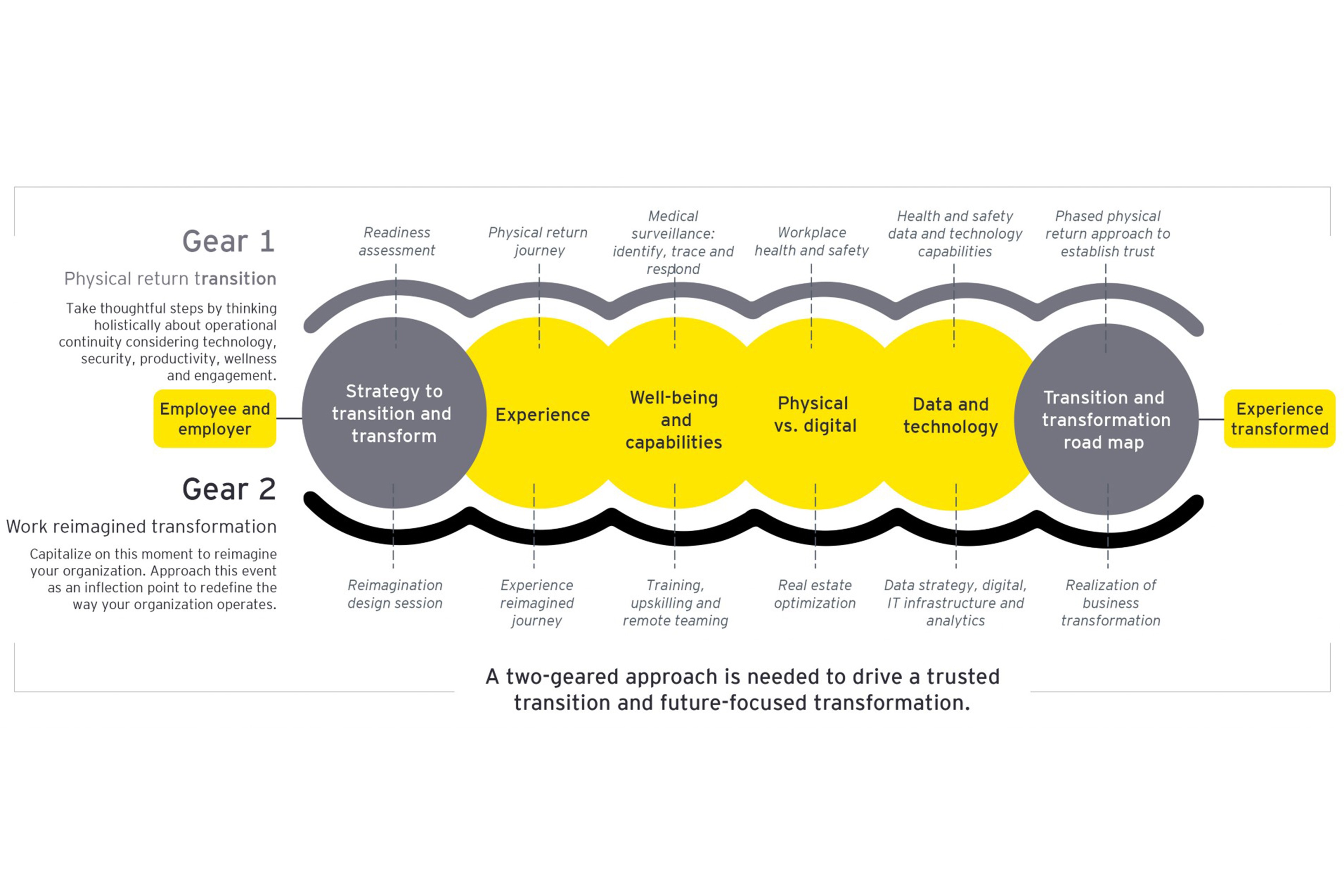
Key takeaways
As we begin to emerge out of lockdown, leaders must rethink the environment in which their companies operate. Succeeding in this uncertain period requires using two gears, moving together, in a maturing cycle of modelling, iterating and pivoting. While Gear 1 focuses on a trusted transition back to physical operations, Gear 2 explores how to transform for the better. Gear 1 focuses on risks; Gear 2 breaks open opportunities. Yet they are interconnected and interdependent, meaning a poorly executed transition will block the path to transformation.
At all times, humans sit at the center of this endeavor. Cracking the code of the next business cycle means mastering a transition from the growth economy to a value-based economy. Companies that win in this emerging world will be those that put people first and best meet their needs, whether they are employees, customers, business partners or society at large.
Summary
Across the world, businesses have been opening their doors, often only to close them again as temporary lockdowns are imposed in response to new outbreaks of COVID-19 infections. But even as lockdowns begin to lift at different paces, it’s anything but business as usual. Effective physical return strategies are factoring in new priorities for employees and new ways of undertaking work.
We suggest a two-gear approach: the first gear focuses on mitigating risks for employees and customers to enable a trusted transition back to physical operations; the second explores how to reimagine work, transforming your organization for the better.
